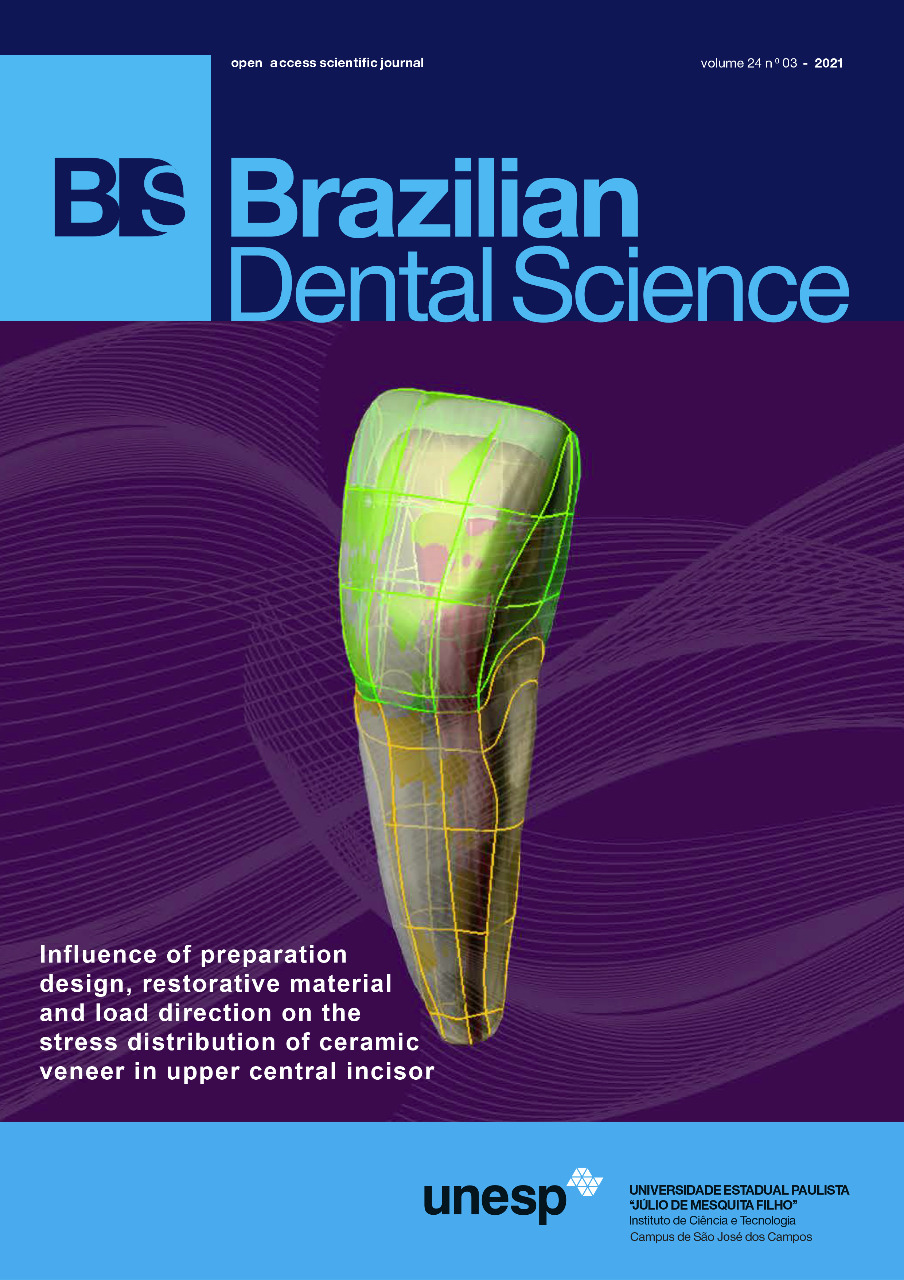Fracture Resistance of Anterior CAD/CAM Nanoceramic Resin Endocrowns with Different Preparation Designs
DOI:
https://doi.org/10.14295/bds.2021.v24i3.2384Abstract
Objective: The aim of the study was to evaluate the effect of extension of endocrown in pulp space and the effect of ferrule on the fracture resistance of anterior endocrowns made of nano-ceramic resin blocks. Material and Methods: Twenty-eight freshly extracted human upper central incisor teeth were prepared to receive CAD/CAM nanoceramic resin endocrowns with four different designs. The specimens were divided into two groups (n = 14) according to the extension of the endocrown inside root canal (A:short and B:long), then each group was further subdivided into another two subgroups (n = 7) according to the presence or absence of ferrule effect (1:ferrule and 2: no ferrule). Endocrowns were then fabricated using CEREC in lab and nanoceramic resin blocks (DENTSPLY Sirona, Germany) and LAVA ultimate (3M ESPE, Germany) blocks size 14L. Results: Two-way ANOVA showed that the ferrule (P > 0.0001) had statistically significant effect on the fracture resistance. However, the extension of the endocrown into the canal had no statistical significant effect on the fracture resistance (P = 0.837). The interactions between the independent variables (extension into the canal and ferrule) had statistically significant effect on the fracture resistance(P = 0.029). Load to fracture for group 1A was 439.53 N, 1B was 306.46 N, 2A was 516.29 N and 2B was 242.04 N. Conclusions: Fracture resistance was not improved by the long or short extensions of the endocrowns in the pulp space, however, the ferrule effect shows significant improvement of the fracture resistance of the nanoceramic resin endocrowns.
Keywords
Anterior endocrowns; Endocrown extensions; Fracture resistance; Nanoceramic resin blocks.
Downloads
References
Sorrentino R, Aversa R, Ferro V, Auriemma T, Zarone F, Ferrari M, Apicella A. Three-dimensional finite element analysis of strain and stress distributions in endodontically treated maxillary central incisors restored with different post, core and crown materials. Dent mater 2007. 23: 983–993.
Sterzenbach G, Franke A, Naumann M. Rigid versus flexible dentin-like endodontic posts--clinical testing of a biomechanical concept: seven-year results of a randomized controlled clinical pilot trial on endodontically treated abutment teeth with severe hard tissue loss. J Endod. 2012. 38(12):1557-1563.
El-Damanhoury HM, Haj-Ali RN, Platt JA. Fracture resistance and microleakage of endocrowns utilizing three CAD-CAM blocks. 2015. 40(2):201-210.
Stricker EJ, Göhring TN. Influence of different posts and cores on marginal adaptation, fracture resistance, and fracture mode of composite resin crowns on human mandibular premolars. An in vitro study. J Dent 2006;34:326-335.
John SA, Anandaraj S, George S. Biologic restoration of a traumatized maxillary central incisor in a toddler: a case report. J Indian Soc Pedod Prev Dent. 2014 32(1):79-82.
Tay FR, Pashley DH. Monoblocks in root canals: a hypothetical or a tangible goal. J Endod 2007;33:391-398.
Tan et al, In vitro fracture resistance of endodontically treated central incisors with varying ferrule heights and configurations. J Prost Dent ,2005, (4)93.
Christensen GJ. Post concepts are changing. Journal of the American Dental Association 2004;135:1308–1310.
Patel D. Conservative preparation guidelines for CAD/CAM restorations. Compend Contin Educ Dent. 2013;34(6):472-475.
3M ESPE Lava Ultimate CAD/CAM Restorative Technical Product Profile (3M ESPE)
Koller M, Arnetzl GV, Holly L, Arnetzl G., Lava ultimate resin nano ceramic for CAD/ CAM: customization case study, Int J Comput Dent. 2012;15(2):159-64.
Scotti R, Valandro F, Galhano GAP, Baldissara P, Bottino MA. Effect of post length on the fatigue resistance of bovine teeth restored with bonded fiber posts: a pilot study. The Int J Prosth 2006;19:504–6.
Da Silva NR, Raposo LH, Versluis A, Fernandes-Neto AJ, Soares CJ. The effect of post, core, crown type, and ferrule presence on the biomechanical behavior of endodontically treated bovine anterior teeth. J Prosth Dent 2010;104:306–17.
Sahafi A, Peutzfeldt A, Ravnholt G, Asmussen E, Gotfredsen K. Resistance to cyclic loading of teeth restored with posts. Clinic Oral Investig 2005;9:84–90.
Akkayan B. An in vitro study evaluating the effect of ferrule length on fracture resistance of endodontically treated teeth restored with fiber-reinforced and zirconia dowel systems. J Prosth Dent 2004;92:155–62.
Schmitter M, Rammelsberg P, Lenz J, Scheuber S, Schweizerhof K, Rues S. Teeth restored using fiber reinforced posts: in vitro fracture tests and finite element analysis. Acta Biomaterialia 2010;6:3747–3754.
Goodacre CJ, Bernal G, Rungcharassaeng K, Kan JY. Clinical complications in fixed prosthodontics. J Prosthet Dent 2003;90:31-41.
F. Zicari, B. Van Meerbeek, R. Scotti, I. Naert, Effect of ferrule and post placement on fracture resistance of endodontically treated teeth after fatigue loading, journal of dentistry 41(2013)207–215.
Naumann M. Effect of incomplete crown ferrules on load capacity of endodontically treated maxillary incisors restored with fiber posts, composite buildups, and all-ceramic crowns: An in vitro evaluation after chewing simulation. Acta Odontologica Scandinavica, 2006; 64: 31_36.
Schiavetti R. and Sannino G, In Vitro Evaluation of Ferrule Effect and Depth of Post Insertion on Fracture Resistance of Fiber Posts, Computational and Mathematical Methods in Medicine Volume 2012, Article ID 816481, 6.
Laden Gulec and Nuran Ulsoy, Effect of Endocrown Restorations with Different CAD/CAM Materials: 3D Finite Element and Weibull Analyses, BioMed Research International 201 (2017) 8.
G.T. Roccaa,⁎, R. Dahera, C.M. Sarattia, R. Sedlacekb, T. Suchyc, A.J. Feilzerd, I. Krejcia, Restoration of severely damaged endodontically treated premolars: Theinfluence of the endo-core length on marginal integrity and fatigue resistance of lithium disilicate CAD-CAM ceramic endocrowns, Journal of Dentistry 68 (2018) 41–5.
Downloads
Published
How to Cite
Issue
Section
License
Brazilian Dental Science uses the Creative Commons (CC-BY 4.0) license, thus preserving the integrity of articles in an open access environment. The journal allows the author to retain publishing rights without restrictions.
=================




























